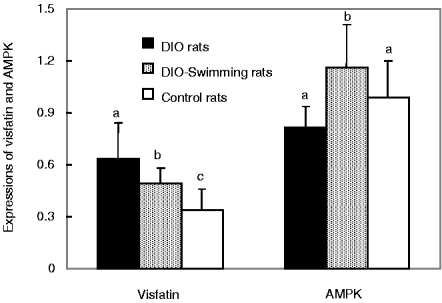Obesity is considered as a chronic condition of clinical significance, obese individuals are subject to a high level of stigmatization resulting in discrimination( Reference Sikorski, Luppa and Kaiser 1 ). Visfatin, known as pre-B cell colony-enhancing factor (PBEF) and nicotinamide phosphoribosyltransferase (Nampt), has been identified as a new adipocytokine affecting insulin resistance by binding to the insulin receptor( Reference Moschen, Kaser and Enrich 2 ). AMPK plays a central role in the development and therapy of metabolic disorders such as diabetes and obesity, and has been recognized as a possible drug target( Reference Schuhmacher, Foretz and Knorr 3 ). Understanding the molecular events initiated by regular exercise can be studied in laboratory animals such as rodents. The model of diet-induced obesity (DIO) in rats has many features in common with human obesity and can serve as a useful model to study the pathogenesis and treatment of obesity( Reference Xiao, Xiang, Harbige and Ai 4 ). The present study investigated the relationship between visfatin and AMPK in DIO and DIO-swimming rats. Male Sprague-Dawley rats (n=110) at 3 weeks of age were randomly assigned into groups. Ten rats were fed rat chow during the study as the control and 100 rats were fed both rat chow plus high fat diet [HFD, 5.58 kcal/g (23.35 kJ/g) with 66.5% as fat/lard] ad libitum for 14 weeks. At the end of this period, 44 rats developed DIO which was assessed by the Lee obesity index( Reference Bernardis and Patterson 5 ). The DIO rat's Lee obesity index was more than the average Lee obesity index plus 2 sd of the chow-fed control rats. At week 15, 10 chow-fed control rats were kept on the rat chow, 11 DIO rats were kept on the rat chow plus HFD ad libitum and the other 11 DIO rats were also kept on the rat chow plus HFD ad libitum and trained to swim at 28–30 °C for 40 min/d and 6 days/week for 5 weeks (DIO-swimming). Other rats were used in other studies (data not presented). Plasma visfatin concentration in DIO-swimming rats and chow-fed control rats tended to be (or was significantly) lower than that of DIO rats. DIO-swimming rats had significantly lower visfatin expression in the visceral adipose tissue than DIO rats, however, they had significantly higher visfatin expression than chow-fed control rats (Figure). Moreover, the activity of AMPK in the visceral adipose tissue was significantly (or tended to be) higher in both DIO-swimming and chow-fed control rats than DIO rats (Figure). These results indicate that exercise which can be part of lifestyle modification, may inactive visfatin and activate AMPK in several ways contributing to glucose and fat oxidation. Visfatin and AMPK may play important roles in the development of obesity.

a, b, c, Mean values with unlike superscripts were significantly different (P<0.05).


